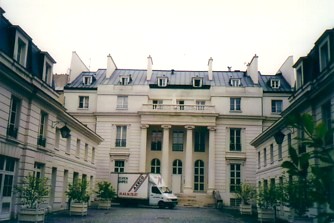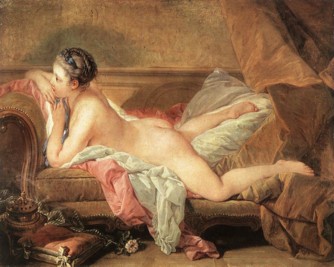Louis
XV's Irish mistress
10th
arrondissement - 30, rue du Faubourg
Poissonière
 Let
us forget the rented truck parked in front and celebrate instead the relative
"dexterity" that was involved in snapping this photograph. A second go at this
one, without the truck, would involve: first, waiting for an occupant of the
private building that hides this 18th century palace from public view to open
the main entrance; second, hoping that said occupant is well disposed to allowing
perfect strangers into the building; third, and most importantly, even supposing
somebody was willing to allow strangers into the courtyard, a further expedition
to 30, rue du Faubourg Poissonire would involve another confrontation with
an archetypical Parisian concierge ready to call the police etc... These creatures
are appropriately known as "Cerbères" in everyday French. [In
Greek mythology, Cerberus was a vicious beast that guarded the entrance to Hades
and kept the living from entering the world of the dead. Cerberus was a strange
mixture of creatures: he had three heads of wild dogs, a dragon or serpent for
a tail, and heads of snakes all over his back. He (she?) also devoured raw flesh.
] How many times have I come across the species in my peregrinations? Too often.
Take my word for it, trying to photograph the "hidden Paris" is not for the
impatient nor the timid.
Let
us forget the rented truck parked in front and celebrate instead the relative
"dexterity" that was involved in snapping this photograph. A second go at this
one, without the truck, would involve: first, waiting for an occupant of the
private building that hides this 18th century palace from public view to open
the main entrance; second, hoping that said occupant is well disposed to allowing
perfect strangers into the building; third, and most importantly, even supposing
somebody was willing to allow strangers into the courtyard, a further expedition
to 30, rue du Faubourg Poissonire would involve another confrontation with
an archetypical Parisian concierge ready to call the police etc... These creatures
are appropriately known as "Cerbères" in everyday French. [In
Greek mythology, Cerberus was a vicious beast that guarded the entrance to Hades
and kept the living from entering the world of the dead. Cerberus was a strange
mixture of creatures: he had three heads of wild dogs, a dragon or serpent for
a tail, and heads of snakes all over his back. He (she?) also devoured raw flesh.
] How many times have I come across the species in my peregrinations? Too often.
Take my word for it, trying to photograph the "hidden Paris" is not for the
impatient nor the timid.
 Quickly,
to the place in hand. This palace was at one stage the home of Louison O'Murphy
(1737-1814), also known as 'Morphise'. Has her biography been written? She deserves
one. Born of an Irish soldier settled in Rouen, she (like her sister) became
one of Louis XV's favourite mistresses and bore him a daughter when she was
17. Some say she was introduced to the King by Casanova, others that the King
summonsed her after viewing the 1752 painting of her by Franois Boucher (see
right). In 1755, Morphise married a major-general, Jacques de Baufranchet,
killed two years later at the battle of Rosbach. During the Terror (1792-1794),
she was imprisoned in an English convent on rue Fossés Saint-Victor. From the
prison records, it appears that she reverted to her Irish name (Lenormand being
her married name at the time). Perhaps she calculated that her Irish connections
were less dangerous than her royalist past.
Quickly,
to the place in hand. This palace was at one stage the home of Louison O'Murphy
(1737-1814), also known as 'Morphise'. Has her biography been written? She deserves
one. Born of an Irish soldier settled in Rouen, she (like her sister) became
one of Louis XV's favourite mistresses and bore him a daughter when she was
17. Some say she was introduced to the King by Casanova, others that the King
summonsed her after viewing the 1752 painting of her by Franois Boucher (see
right). In 1755, Morphise married a major-general, Jacques de Baufranchet,
killed two years later at the battle of Rosbach. During the Terror (1792-1794),
she was imprisoned in an English convent on rue Fossés Saint-Victor. From the
prison records, it appears that she reverted to her Irish name (Lenormand being
her married name at the time). Perhaps she calculated that her Irish connections
were less dangerous than her royalist past.
And Irish involvement with royalty
at the time of the Revolution does not end there. On Jan. 21, 1793, while O'Murphy
languished in prison, Louis XVI mounted the scaffold, leaning on the arm of
the Abbé Edgeworth, his confessor and uncle of the novelist Maria Edgeworth.
(More on Abbé Edgeworth at www.irish-paris.org)
 Return
to home page
Return
to home page  To
top of the page
To
top of the page
 Let
us forget the rented truck parked in front and celebrate instead the relative
"dexterity" that was involved in snapping this photograph. A second go at this
one, without the truck, would involve: first, waiting for an occupant of the
private building that hides this 18th century palace from public view to open
the main entrance; second, hoping that said occupant is well disposed to allowing
perfect strangers into the building; third, and most importantly, even supposing
somebody was willing to allow strangers into the courtyard, a further expedition
to 30, rue du Faubourg Poissonire would involve another confrontation with
an archetypical Parisian concierge ready to call the police etc... These creatures
are appropriately known as "Cerbères" in everyday French. [In
Greek mythology, Cerberus was a vicious beast that guarded the entrance to Hades
and kept the living from entering the world of the dead. Cerberus was a strange
mixture of creatures: he had three heads of wild dogs, a dragon or serpent for
a tail, and heads of snakes all over his back. He (she?) also devoured raw flesh.
] How many times have I come across the species in my peregrinations? Too often.
Take my word for it, trying to photograph the "hidden Paris" is not for the
impatient nor the timid.
Let
us forget the rented truck parked in front and celebrate instead the relative
"dexterity" that was involved in snapping this photograph. A second go at this
one, without the truck, would involve: first, waiting for an occupant of the
private building that hides this 18th century palace from public view to open
the main entrance; second, hoping that said occupant is well disposed to allowing
perfect strangers into the building; third, and most importantly, even supposing
somebody was willing to allow strangers into the courtyard, a further expedition
to 30, rue du Faubourg Poissonire would involve another confrontation with
an archetypical Parisian concierge ready to call the police etc... These creatures
are appropriately known as "Cerbères" in everyday French. [In
Greek mythology, Cerberus was a vicious beast that guarded the entrance to Hades
and kept the living from entering the world of the dead. Cerberus was a strange
mixture of creatures: he had three heads of wild dogs, a dragon or serpent for
a tail, and heads of snakes all over his back. He (she?) also devoured raw flesh.
] How many times have I come across the species in my peregrinations? Too often.
Take my word for it, trying to photograph the "hidden Paris" is not for the
impatient nor the timid.  Quickly,
to the place in hand. This palace was at one stage the home of Louison O'Murphy
(1737-1814), also known as 'Morphise'. Has her biography been written? She deserves
one. Born of an Irish soldier settled in Rouen, she (like her sister) became
one of Louis XV's favourite mistresses and bore him a daughter when she was
17. Some say she was introduced to the King by Casanova, others that the King
summonsed her after viewing the 1752 painting of her by Franois Boucher (see
right). In 1755, Morphise married a major-general, Jacques de Baufranchet,
killed two years later at the battle of Rosbach. During the Terror (1792-1794),
she was imprisoned in an English convent on rue Fossés Saint-Victor. From the
prison records, it appears that she reverted to her Irish name (Lenormand being
her married name at the time). Perhaps she calculated that her Irish connections
were less dangerous than her royalist past.
Quickly,
to the place in hand. This palace was at one stage the home of Louison O'Murphy
(1737-1814), also known as 'Morphise'. Has her biography been written? She deserves
one. Born of an Irish soldier settled in Rouen, she (like her sister) became
one of Louis XV's favourite mistresses and bore him a daughter when she was
17. Some say she was introduced to the King by Casanova, others that the King
summonsed her after viewing the 1752 painting of her by Franois Boucher (see
right). In 1755, Morphise married a major-general, Jacques de Baufranchet,
killed two years later at the battle of Rosbach. During the Terror (1792-1794),
she was imprisoned in an English convent on rue Fossés Saint-Victor. From the
prison records, it appears that she reverted to her Irish name (Lenormand being
her married name at the time). Perhaps she calculated that her Irish connections
were less dangerous than her royalist past.  Return
to home page
Return
to home page To
top of the page
To
top of the page